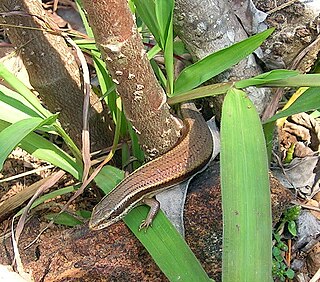
Skinks are lizards belonging to the family Scincidae, a family in the infraorder Scincomorpha. With more than 1,500 described species across 100 different taxonomic genera, the family Scincidae is one of the most diverse families of lizards. Skinks are characterized by their smaller legs in comparison to typical lizards and are found in different habitats except arctic and subarctic regions.
Lobulia is a genus of skinks in the subfamily Eugongylinae. The genus Lobulia is endemic to New Guinea.

Oligosoma is a genus of small to medium-sized skinks found only in New Zealand, Norfolk Island and Lord Howe Island. Oligosoma had previously been found to belong to the Eugongylus group of genera in the subfamily Lygosominae; the Australian genus Bassiana appears to be fairly closely related.

The Bermuda skink, longnose skink, or (Bermuda) rock lizard is a critically endangered species and the only endemic land-living vertebrate of Bermuda. It is a relatively small skink : adults reach an average snout-to-vent length of about 8 cm (3.1 in).

Leo Daniel Brongersma was a Dutch zoologist, herpetologist, author, and lecturer.

Scincomorpha is an infraorder and clade of lizards including skinks (Scincidae) and their close relatives. These include the living families Cordylidae, Gerrhosauridae, and Xantusiidae, as well as many extinct taxa. Other roughly equivalent terms include the suborder Scinciformata, or the superfamily Scincoidea, though different authors use these terms in a broader or more restricted usage relative to true skinks. They first appear in the fossil record about 170 million years ago, during the Jurassic period.

Lygosominae is the largest subfamily of skinks in the family Scincidae. The subfamily can be divided into a number of genus groups. If the rarely used taxonomic rank of infrafamily is employed, the genus groups would be designated as such, but such a move would require a formal description according to the ICZN standards.
Lobulia elegans, the elegant lobulia, is a species of skink found in New Guinea.

Eugongylinae is a subfamily of skinks within the family Scincidae. The genera in this subfamily were previously found to belong the Eugongylus group in the large subfamily Lygosominae.
Alpinoscincus alpinus is a species of skink found in Papua New Guinea.
Lobulia brongersmai, also known as the Brongersma's lobulia, is a species of skink, a lizard in the family Scincidae. The species is endemic to the island of New Guinea.
Alpinoscincus subalpinus is a species of skink found in Papua New Guinea.
Papuascincus buergersi is a species of skink, a lizard in the family Scincidae. The species is endemic to Papua New Guinea.
The elegant lobulia is a species of skink found in New Guinea.
Lobulia fortis, or the Mount Strong moss skink, is a species of skink endemic to Papua New Guinea.
Lobulia huonensis is a species of skink found in Papua New Guinea.
Lobulia marmorata, or the marbled moss skink, is a species of skink found in Papua New Guinea.
Nubeoscincus is a genus of skinks in the subfamily Eugongylinae. The genus Nubeoscincus is endemic to New Guinea. The genus name, derived from Latin nubes (=cloud) and scincus, refers to high elevations at which species in this genus occur.

Ornithuroscincus is a genus of skinks, lizards in the family Scincidae. All but one species are endemic to New Guinea: in addition to northern New Guinea, Ornithuroscincus noctua occurs on many Pacific islands.
Ornithuroscincus viridis is a species of skink. It is endemic to the Owen Stanley Range in the Central Province, southeastern Papua New Guinea. Common name green smooth-eared skink has been coined for it.







